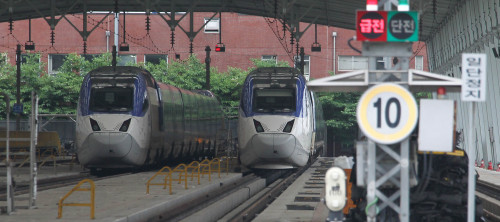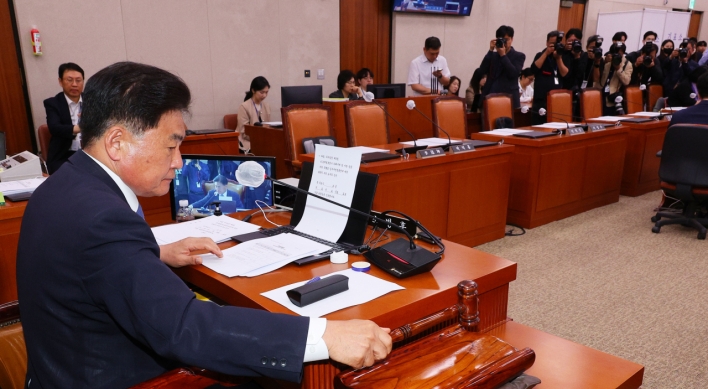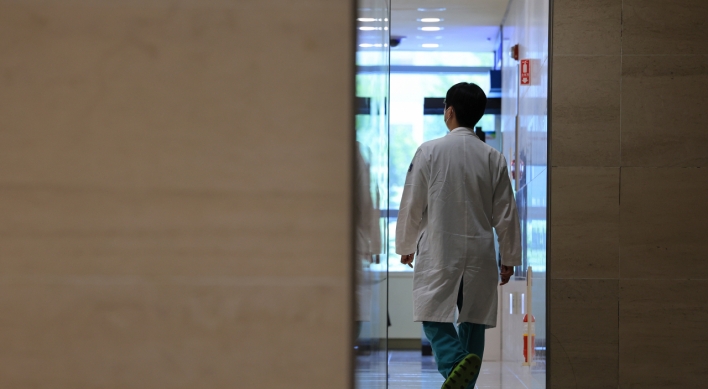A string of KTX breakdowns dampens confidence in homegrown technology, stokes safety concerns
Customers around the country have vented fury over Korea’s flaw-ridden high-speed trains, calling for better safety measures from operators and builders.
A series of accidents and breakdowns have marred the reputation of the Korea Train Express, or KTX, in recent months largely due to technical glitches.
State-run railway operator KORAIL, the Korea Rail Network Authority (KR) and train manufacturer Hyundai Rotem have come under fire as they try to pass the buck to each other while playing down the significance of the problems.
Even though no fatalities or major accidents have been reported, the public has become more anxious following a recent collision in China, which killed at least 43 and injured 200.
The series of accidents also poses a setback for the Korean government’s ambition to export the homegrown rail technology to other regions including Brazil, the Middle East and California.
Customers around the country have vented fury over Korea’s flaw-ridden high-speed trains, calling for better safety measures from operators and builders.
A series of accidents and breakdowns have marred the reputation of the Korea Train Express, or KTX, in recent months largely due to technical glitches.
State-run railway operator KORAIL, the Korea Rail Network Authority (KR) and train manufacturer Hyundai Rotem have come under fire as they try to pass the buck to each other while playing down the significance of the problems.
Even though no fatalities or major accidents have been reported, the public has become more anxious following a recent collision in China, which killed at least 43 and injured 200.
The series of accidents also poses a setback for the Korean government’s ambition to export the homegrown rail technology to other regions including Brazil, the Middle East and California.

Angry customers
On July 17, two KTX trains broke down just hours apart. One was brought to an abrupt stop inside a tunnel near Busan by a flawed motor system, leaving about 400 passengers stranded for one hour.
Three hours later, another Busan-to-Seoul train had an air-conditioning failure. After sweating for two hours, some 800 passengers were transferred to other trains as repairmen failed to fix it.
“It is a fact that my life became easier since the KTX, but now I get really nervous when the train rattles a bit along the rails,” said Sohn Mi-jeong, 23, who uses Seoul-Daegu services about 10 times a year.
Earlier that month, around 180 passengers heading to the southeastern city of Masan were evacuated after a short circuit caused smoke in the rear of the train.
“I was previously very proud of the KTX as it’s very fast and convenient, but now I feel very apprehensive and even reluctant to use it,” said Kim Mi-yeon, a 58-year-old Masan resident, who visits her son in Seoul every other month.
“The other day I asked one of the crew how they are handling all those reported flaws, they appear to just think of them as nothing really serious.”
In the most serious case, a train derailed near Gwangmyeong Station, south of Seoul, in February, as a result of slack maintenance.
The number of accidents and breakdowns reached 37 so far this year, and on the rise. Between 2007 and 2009, the figure averaged 26 a year. But last year, it more than doubled to 53.
“I understand some minor breakdowns are inevitable but this has gone too far,” said Shin, a 33-year-old company worker who declined to give his full name, adding he uses the KTX twice a month to go home in Ulsan. “Something has to be done before someone dies in a serious accident.”
Who is to blame?
The frequent breakdowns are chiefly driven by the KTX-Sancheon, the local version of bullet trains made by Hyundai. It started commercial service in March 2010, but experts said the trains had “fundamental problems” with design, manufacturing and test run.
“When laying out high-speed trains, you also have to consider other factors ― the condition of tracks, operation methods and quality of raw materials to use, as well as geological and climatic circumstances,” said Kim Chan-oh, a professor at Seoul National University of Science and Technology’s railroad program.
“Our technology still needs improvement compared with those owned by countries like France and Japan.”
Many also pointed out the builders did not carry out sufficient trial operations before delivery.
Cho Hyun-yong, chairman and chief executive of the KR, said Korea does not have tracks that are exclusively built for test runs. The state-funded authority is in charge of overall railway construction.
“Although we’re striving to localize many components, there is nowhere to try them. We just have to find inactive railroads in the countryside,” Cho told reporters in June.
The lack of test tracks could dent the system’s entire quality, said Kim Ki-hwan, chief researcher of high-speed rail systems at the Korea Railroad Research Institute.
“The current trial operations focus on complying with the government’s 40,000-kilometer requirement, rather than improving quality. Things are still difficult here,” he said.
In all cases, KORAIL quickly apologized but has been ascribing the failures to manufacturing defects.
According to Hyundai, although all of its 19 trains undergo test runs, not all faults were detected during the phase. The company is trying to fix any potential problems that may have been overlooked, but denied a total recall.
“We do not know the exact cause of the problem,” a Hyundai official said. “As the train has been running for more than a year, determining the cause of the fault will need close examination.”
Safety check
Following July breakdowns, officials at the Board of Audit and Inspection said they will launch a probe soon to get to the bottom of the cases.
The government also devised measures to step up safety, including a special inspection on all trains and stricter requirement for component replacement.
It also decided to set up what it called a “maintenance steering group” to ensure better maintenance.
Still, some are demanding a suspension of all KTX operations for a more comprehensive examination.
“They should have a break if they really want to know what’s wrong and regain public trust,” said Hong Ji-hyun, a 26-year-old company employee. “It would of course cause inconvenience to some regular passengers, but in the past didn’t they live even without knowing there’s such a thing?”
By Shin Hyon-hee (heeshin@heraldcorp.com)










![[Kim Seong-kon] Democracy and the future of South Korea](http://res.heraldm.com/phpwas/restmb_idxmake.php?idx=644&simg=/content/image/2024/04/16/20240416050802_0.jpg&u=)








![[Today’s K-pop] Zico drops snippet of collaboration with Jennie](http://res.heraldm.com/phpwas/restmb_idxmake.php?idx=642&simg=/content/image/2024/04/18/20240418050702_0.jpg&u=)